Characterization of Hydrologic Sand and Dust Storm Sources in the Middle East
Abstract
:1. Introduction
2. Materials and Methods
Methodology
- Identifying SDS sources (Stp. 1)
- SDS Source Discrimination (Stp. 2)
- Surface and ground water changes (Stp. 3)
3. Results
3.1. Identification and Attribution of SDS Sources
3.2. Temporal Analysis of Surface and Ground Water Changes in Hydrologic SDS Sources
3.3. Spatial Analysis of Surface and Ground Water Changes in Hydrologic SDS Sources
4. Discussion
4.1. Characterization of Middle Eastern SDS Sources
4.2. Influence of Drought on SDS Sources in Middle East
4.3. Influence of Human Interventions on Middle Eastern SDS Sources
5. Conclusions
Author Contributions
Funding
Institutional Review Board Statement
Informed Consent Statement
Data Availability Statement
Acknowledgments
Conflicts of Interest
References
- Zittis, G.; Almazroui, M.; Alpert, P.; Ciais, P.; Cramer, W.; Dahdal, Y.; Fnais, M.; Francis, D.; Hadjinicolaou, P.; Howari, F.; et al. Climate Change and Weather Extremes in the Eastern Mediterranean and Middle East. Rev. Geophys. 2022, 60, e2021RG000762. [Google Scholar] [CrossRef]
- Boloorani, A.D.; Najafi, M.S.; Soleimani, M.; Papi, R.; Torabi, O. Influence of Hamoun Lakes’ dry conditions on dust emission and radiative forcing over Sistan plain, Iran. Atmospheric Res. 2022, 272, 106152. [Google Scholar] [CrossRef]
- Francis, D.; Chaboureau, J.P.; Nelli, N.; Cuesta, J.; Alshamsi, N.; Temimi, M.; Pauluis, O.; Xue, L. Summertime dust storms over the Arabian Peninsula and impacts on radiation, circulation, cloud devel-opment and rain. Atmos. Res. 2021, 250, 105364. [Google Scholar] [CrossRef]
- Khaniabadi, Y.O.; Daryanoosh, S.M.; Amrane, A.; Polosa, R.; Hopke, P.K.; Goudarzi, G.; Mohammadi, M.J.; Sicard, P.; Armin, H. Impact of Middle Eastern Dust storms on human health. Atmos. Pollut. Res. 2017, 8, 606–613. [Google Scholar] [CrossRef]
- Soleimani, Z.; Teymouri, P.; Boloorani, A.D.; Mesdaghinia, A.; Middleton, N.; Griffin, D.W. An overview of bioaerosol load and health impacts associated with dust storms: A focus on the Middle East. Atmos. Environ. 2020, 223, 117187. [Google Scholar] [CrossRef]
- Middleton, N.; Kashani, S.S.; Attarchi, S.; Rahnama, M.; Mosalman, S.T. Synoptic Causes and Socio-Economic Consequences of a Severe Dust Storm in the Middle East. Atmosphere 2021, 12, 1435. [Google Scholar] [CrossRef]
- Jish Prakash, P.; Stenchikov, G.; Kalenderski, S.; Osipov, S.; Bangalath, H. The impact of dust storms on the Arabian Pen-insula and the Red Sea. Atmos. Chem. Phys. 2015, 15, 199–222. [Google Scholar] [CrossRef] [Green Version]
- Rezazadeh, M.; Irannejad, P.; Shao, Y. Climatology of the Middle East dust events. Aeolian Res. 2013, 10, 103–109. [Google Scholar] [CrossRef]
- Kutiel, H.; Furman, H.K.H. Dust Storms in the Middle East: Sources of Origin and Their Temporal Characteristics. Indoor Built Environ. 2003, 12, 419–426. [Google Scholar] [CrossRef]
- World Bank. Sand and Dust Storms in the Middle East and North Africa Region: Sources, Costs, and Solutions; World Bank: Washington, DC, USA, 2019. [Google Scholar]
- Heydarizad, M.; Minaei, M.; Ichiyanagi, K.; Sorí, R. The effects of local and regional parameters on the δ18O and δ2H values of precipitation and surface water resources in the Middle East. J. Hydrol. 2021, 600, 126485. [Google Scholar] [CrossRef]
- Bozorg-Haddad, O.; Zolghadr-Asli, B.; Sarzaeim, P.; Aboutalebi, M.; Chu, X.; Loáiciga, H.A. Evaluation of water shortage crisis in the Middle East and possible remedies. J. Water Supply: Res. Technol. 2020, 69, 85–98. [Google Scholar] [CrossRef]
- Boloorani, A.D.; Papi, R.; Soleimani, M.; Karami, L.; Amiri, F.; Samany, N.N. Water bodies changes in Tigris and Euphrates basin has impacted dust storms phenomena. Aeolian Res. 2021, 50, 100698. [Google Scholar] [CrossRef]
- Hamzeh, N.H.; Karami, S.; Opp, C.; Fattahi, E.; Jean-François, V. Spatial and temporal variability in dust storms in the Middle East, 2002–2018: Three case studies in July 2009. Arab. J. Geosci. 2021, 14, 538. [Google Scholar] [CrossRef]
- Papi, R.; Kakroodi, A.; Soleimani, M.; Karami, L.; Amiri, F.; Alavipanah, S.K. Identifying sand and dust storm sources using spatial-temporal analysis of remote sensing data in Central Iran. Ecol. Inform. 2022, 70, 101724. [Google Scholar] [CrossRef]
- Gholami, H.; Mohamadifar, A.; Collins, A.L. Spatial mapping of the provenance of storm dust: Application of data mining and ensemble modelling. Atmos. Res. 2020, 233, 104716. [Google Scholar] [CrossRef]
- Boroughani, M.; Pourhashemi, S.; Hashemi, H.; Salehi, M.; Amirahmadi, A.; Asadi, M.A.Z.; Berndtsson, R. Application of remote sensing techniques and machine learning algorithms in dust source detection and dust source susceptibility mapping. Ecol. Inform. 2020, 56, 101059. [Google Scholar] [CrossRef]
- Papi, R.; Argany, M.; Moradipour, S.; Soleimani, M. Modeling the potential of Sand and Dust Storm sources formation using time series of remote sensing data, fuzzy logic and artificial neural network (A Case study of Euphrates basin). Eng. J. Geo-spatial Inf. Technol. 2021, 8, 61–82. [Google Scholar] [CrossRef]
- Boloorani, A.D.; Samany, N.N.; Papi, R.; Soleimani, M. Dust source susceptibility mapping in Tigris and Euphrates basin using remotely sensed imagery. Catena 2022, 209, 105795. [Google Scholar] [CrossRef]
- Boloorani, A.D.; Kazemi, Y.; Sadeghi, A.; Shorabeh, S.N.; Argany, M. Identification of dust sources using long term satellite and climatic data: A case study of Tigris and Euphrates basin. Atmos. Environ. 2020, 224, 117299. [Google Scholar] [CrossRef]
- Rashki, A.; Middleton, N.J.; Goudie, A.S. Dust storms in Iran–Distribution, causes, frequencies and impacts. Aeolian Res. 2021, 48, 100655. [Google Scholar] [CrossRef]
- Ginoux, P.; Prospero, J.M.; Gill, T.E.; Hsu, N.C.; Zhao, M. Global-scale attribution of anthropogenic and natural dust sources and their emission rates based on MODIS Deep Blue aerosol products. Rev. Geophys. 2012, 50. [Google Scholar] [CrossRef]
- Cao, H.; Amiraslani, F.; Liu, J.; Zhou, N. Identification of dust storm source areas in West Asia using multiple environmental datasets. Sci. Total Environ. 2015, 502, 224–235. [Google Scholar] [CrossRef] [PubMed]
- Moridnejad, A.; Karimi, N.; Ariya, P.A. A new inventory for middle east dust source points. Environ. Monit. Assess. 2015, 187, 1–11. [Google Scholar] [CrossRef]
- Moridnejad, A.; Karimi, N.; Ariya, P.A. Newly desertified regions in Iraq and its surrounding areas: Significant novel sources of global dust particles. J. Arid Environ. 2015, 116, 1–10. [Google Scholar] [CrossRef]
- Parajuli, S.P.; Yang, Z.; Kocurek, G. Mapping erodibility in dust source regions based on geomorphology, meteorology, and remote sensing. J. Geophys. Res. Earth Surf. 2014, 119, 1977–1994. [Google Scholar] [CrossRef]
- Hamidi, M. The key role of water resources management in the Middle East dust events. Catena 2020, 187, 104337. [Google Scholar] [CrossRef]
- Boroughani, M.; Hashemi, H.; Hosseini, S.H.; Pourhashemi, S.; Berndtsson, R. Desiccating Lake Urmia: A New Dust Source of Regional Importance. IEEE Geosci. Remote Sens. Lett. 2019, 17, 1483–1487. [Google Scholar] [CrossRef]
- Ghale, Y.A.G.; Tayanc, M.; Unal, A. Dried bottom of Urmia Lake as a new source of dust in the northwestern Iran: Understanding the impacts on local and regional air quality. Atmospheric Environ. 2021, 262, 118635. [Google Scholar] [CrossRef]
- Rashki, A.; Kaskaoutis, D.; Goudie, A.; Kahn, R. Dryness of ephemeral lakes and consequences for dust activity: The case of the Hamoun drainage basin, southeastern Iran. Sci. Total Environ. 2013, 463–464, 552–564. [Google Scholar] [CrossRef]
- Miri, A.; Maleki, S.; Middleton, N. An investigation into climatic and terrestrial drivers of dust storms in the Sistan region of Iran in the early twenty-first century. Sci. Total Environ. 2021, 757, 143952. [Google Scholar] [CrossRef]
- Thakur, P.K.; Nikam, B.R.; Garg, V.; Aggarwal, S.P.; Chouksey, A.; Dhote, P.R.; Ghosh, S. Hydrological Parameters Estimation Using Remote Sensing and GIS for Indian Region: A Review. Proc. Natl. Acad. Sci. India Sect. A Phys. Sci. 2017, 87, 641–659. [Google Scholar] [CrossRef]
- O’Loingsigh, T.; Mitchell, R.; Campbell, S.; Drake, N.; McTainsh, G.; Tapper, N.; Dunkerley, D. Correction of dust event frequency from MODIS Quick-Look imagery using in-situ aerosol measurements over the Lake Eyre Basin, Australia. Remote Sens. Environ. 2015, 169, 222–231. [Google Scholar] [CrossRef]
- Baddock, M.C.; Bryant, R.G.; Acosta, M.D.; Gill, T.E. Understanding dust sources through remote sensing: Making a case for CubeSats. J. Arid Environ. 2021, 184, 104335. [Google Scholar] [CrossRef]
- Prospero, J.M.; Ginoux, P.; Torres, O.; Nicholson, S.E.; Gill, T.E. Environmental characterization of global sources of at-mospheric soil dust identified with the Nimbus 7 Total Ozone Mapping Spectrometer (TOMS) absorbing aerosol product. Rev. Geophys. 2002, 40, 1–2. [Google Scholar] [CrossRef]
- Karimi, N.; Moridnejad, A.; Golian, S.; Samani, J.M.V.; Karimi, D.; Javadi, S. Comparison of dust source identification techniques over land in the Middle East region using MODIS data. Can. J. Remote Sens. 2012, 38, 586–599. [Google Scholar] [CrossRef]
- Soleimani, M.; Argany, M.; Papi, R.; Amiri, F. Satellite aerosol optical depth prediction using data mining of climate parameters. Phys. Geogr. Res. Q. 2021, 53, 319–333. [Google Scholar] [CrossRef]
- Stein Zweers, D.C. TROPOMI ATBD of the UV aerosol index. S5P-KNMI-L2-0008-RP. 1.0. Available online: http://www.tropomi.eu/sites/default/files/files (accessed on 1 August 2022).
- Nabavi, S.O.; Haimberger, L.; Samimi, C. Climatology of dust distribution over West Asia from homogenized remote sensing data. Aeolian Res. 2016, 21, 93–107. [Google Scholar] [CrossRef] [Green Version]
- Shepherd, G.; Terradellas, E.; Baklanov, A.; Kang, U.; Sprigg, W.; Nickovic, S.; Joowan, C. Global Assessment of Sand and Dust Storms; WMO: Geneva, Switzerland, 2016. [Google Scholar]
- Abatzoglou, J.T.; Dobrowski, S.Z.; Parks, S.A.; Hegewisch, K.C. TerraClimate, a high-resolution global dataset of monthly climate and climatic water balance from 1958–2015. Sci. Data 2018, 5, 170191. [Google Scholar] [CrossRef] [Green Version]
- Pelletier, J.D.; Broxton, P.D.; Hazenberg, P.; Zeng, X.; Troch, P.A.; Niu, G.; Williams, Z.C.; Brunke, M.A.; Gochis, D. Global 1-km Gridded Thickness of Soil, Regolith, and Sedimentary Deposit Layers; ORNL DAAC: Oak Ridge, TN, USA, 2016. [Google Scholar]
- Lehner, B.; Döll, P. Development and validation of a global database of lakes, reservoirs and wetlands. J. Hydrol. 2004, 296, 1–22. [Google Scholar] [CrossRef]
- Pekel, J.-F.; Cottam, A.; Gorelick, N.; Belward, A.S. High-resolution mapping of global surface water and its long-term changes. Nature 2016, 540, 418–422. [Google Scholar] [CrossRef]
- Gao, B.-C. Normalized Difference Water Index for Remote Sensing of Vegetation Liquid Water from Space. In Proceedings of the SPIE’S 1995 Symposium on OE/Aerospace Sensing and Dual Use Photonics, Orlando, FL, USA, 17–21 April 1995; pp. 225–236. [Google Scholar] [CrossRef]
- Darvishi Boloorani, A.; Soleimani, M.; Papi, R.; Alavipanah, S.K.; Al-Quraishi, A.M.F. Zoning Areas Susceptible to Land Subsidence in Tigris and Euphrates Basins. Eng. Technol. J. 2019, 37, 265–272. [Google Scholar] [CrossRef]
- Barlow, M.; Zaitchik, B.; Paz, S.; Black, E.; Evans, J.; Hoell, A. A Review of Drought in the Middle East and Southwest Asia. J. Clim. 2016, 29, 8547–8574. [Google Scholar] [CrossRef]
- Middleton, N.; Kang, U. Sand and Dust Storms: Impact Mitigation. Sustainability 2017, 9, 1053. [Google Scholar] [CrossRef] [Green Version]
- Al-Ansari, N.; Adamo, N.; Sissakian, V. Water shortages and its environmental consequences within Tigris and Euphrates Rivers. J. Earth Sci. Geotech. Eng. 2019, 9, 27–56. [Google Scholar]
- Batanouny, K.H. Climatic Aridity in the Deserts of the Middle East. In Plants in the Deserts of the Middle East; Springer: Berlin/Heidelberg, Germany, 2001; pp. 11–24. [Google Scholar] [CrossRef]
- Bolin, B.; Aspling, G.; Persson, C. Residence time of atmospheric pollutants as dependent on source characteristics, at-mospheric diffussion processes and sink mechanisms. Tellus 1974, 26, 185–195. [Google Scholar] [CrossRef] [Green Version]
- Trigo, R.M.; Gouveia, C.; Barriopedro, D. The intense 2007–2009 drought in the Fertile Crescent: Impacts and associated atmospheric circulation. Agric. For. Meteorol. 2010, 150, 1245–1257. [Google Scholar] [CrossRef]
- Yadollahie, M. The Flood in Iran: A Consequence of the Global Warming? Int. J. Occup. Environ. Med. 2019, 10, 54–56. [Google Scholar] [CrossRef] [Green Version]
- Roudi-Fahimi, F.; Creel, L.; De Souza, R.-M. Finding the Balance: Population and Water Scarcity in the Middle East and North Africa; Population Reference Bureau: Washington, DC, USA, 2002. [Google Scholar]
- Allan, J.A. Hydro-Peace in the Middle East. SAIS Rev. 2002, 22, 255–272. [Google Scholar] [CrossRef]
- Amery, H.A. Water wars in the Middle East: A looming threat. Geogr. J. 2002, 168, 313–323. [Google Scholar] [CrossRef]
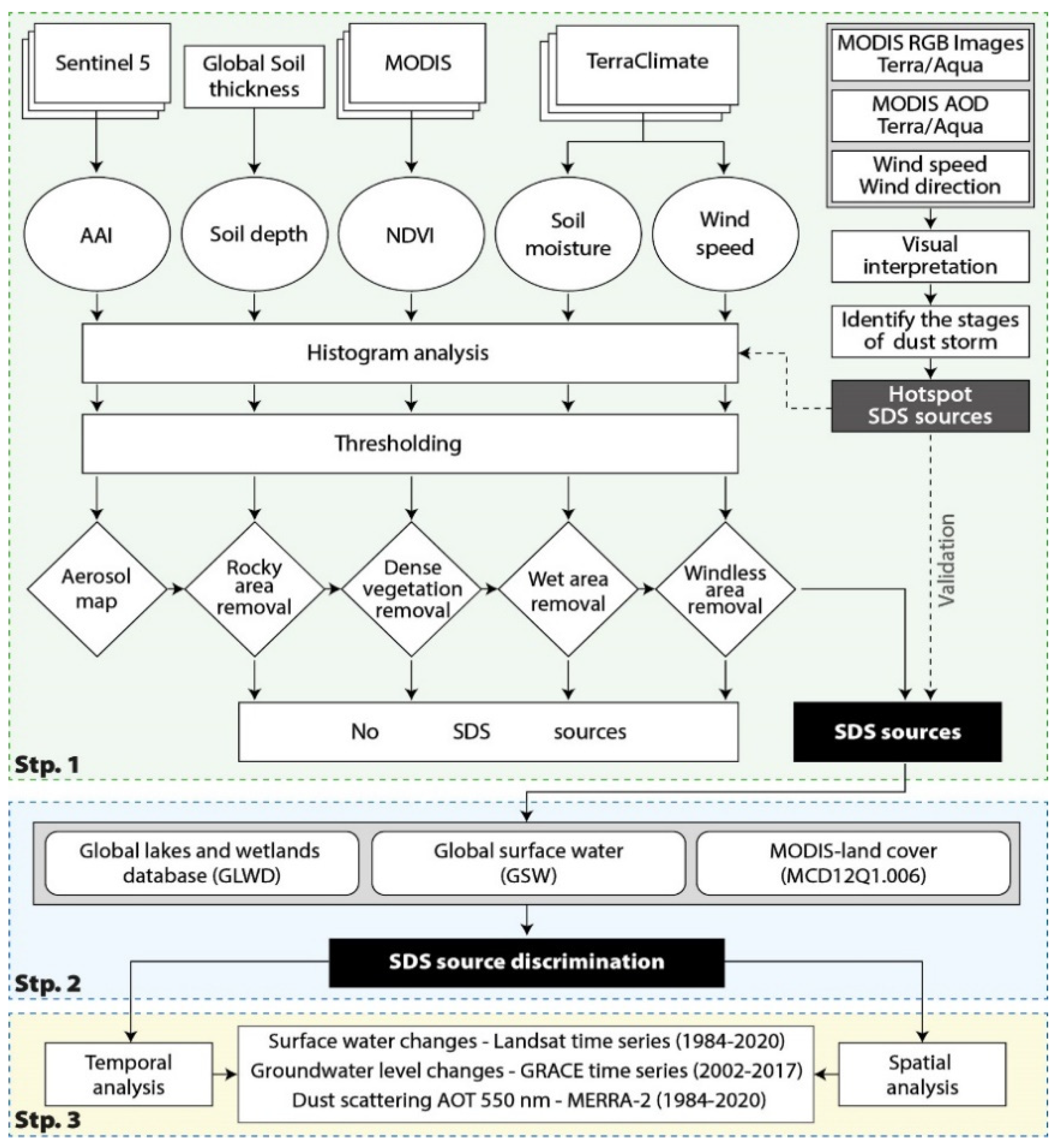
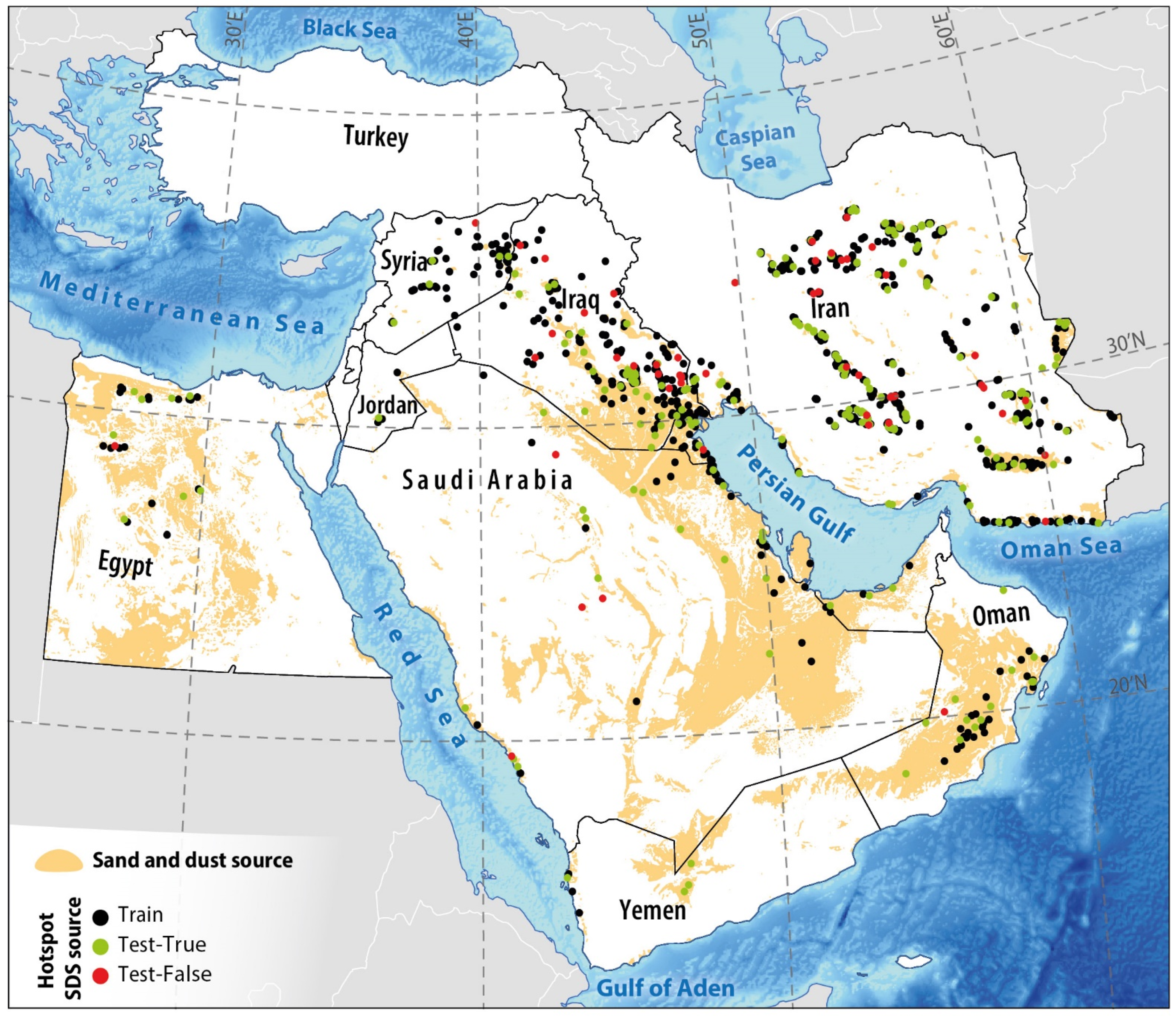
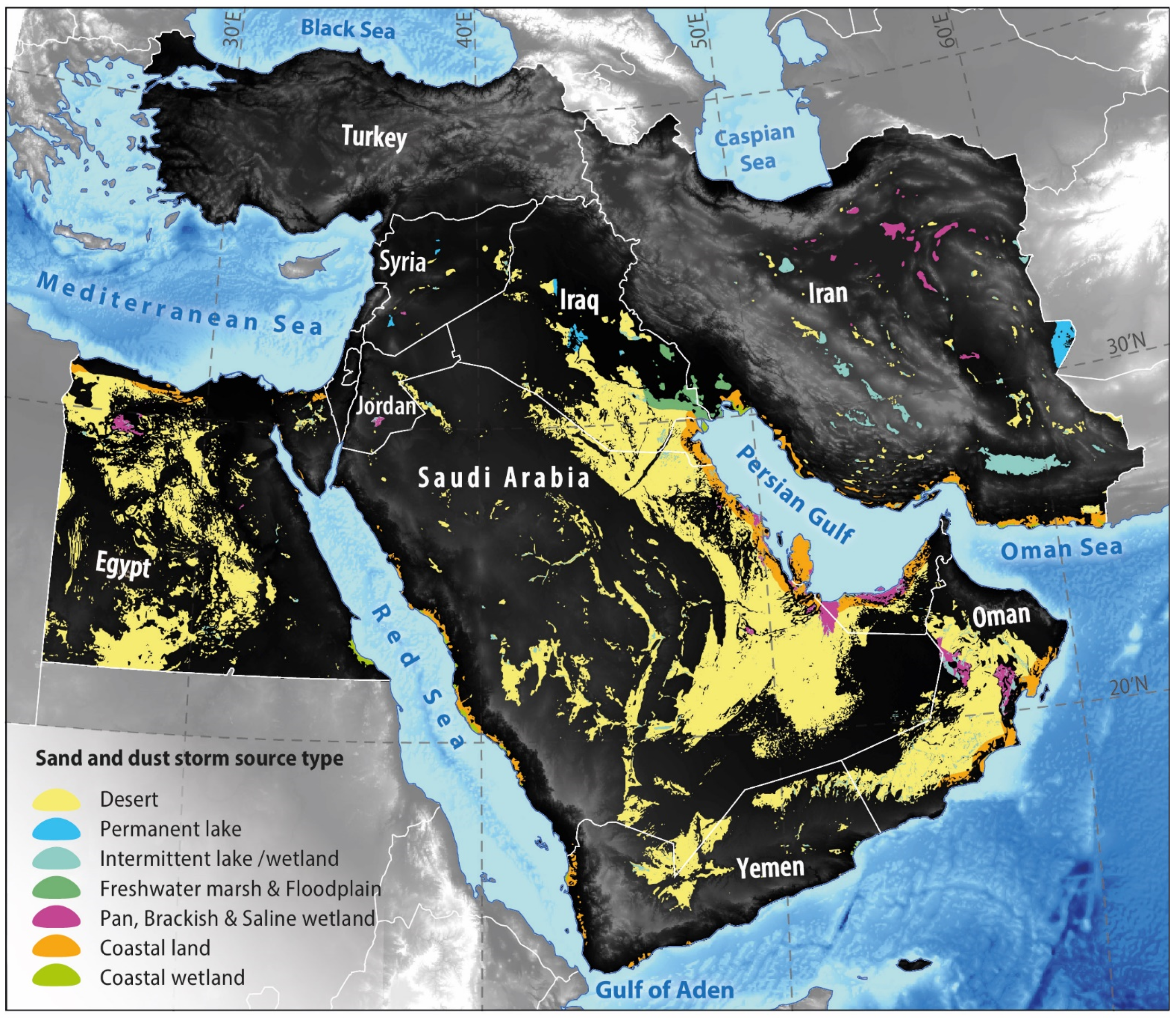

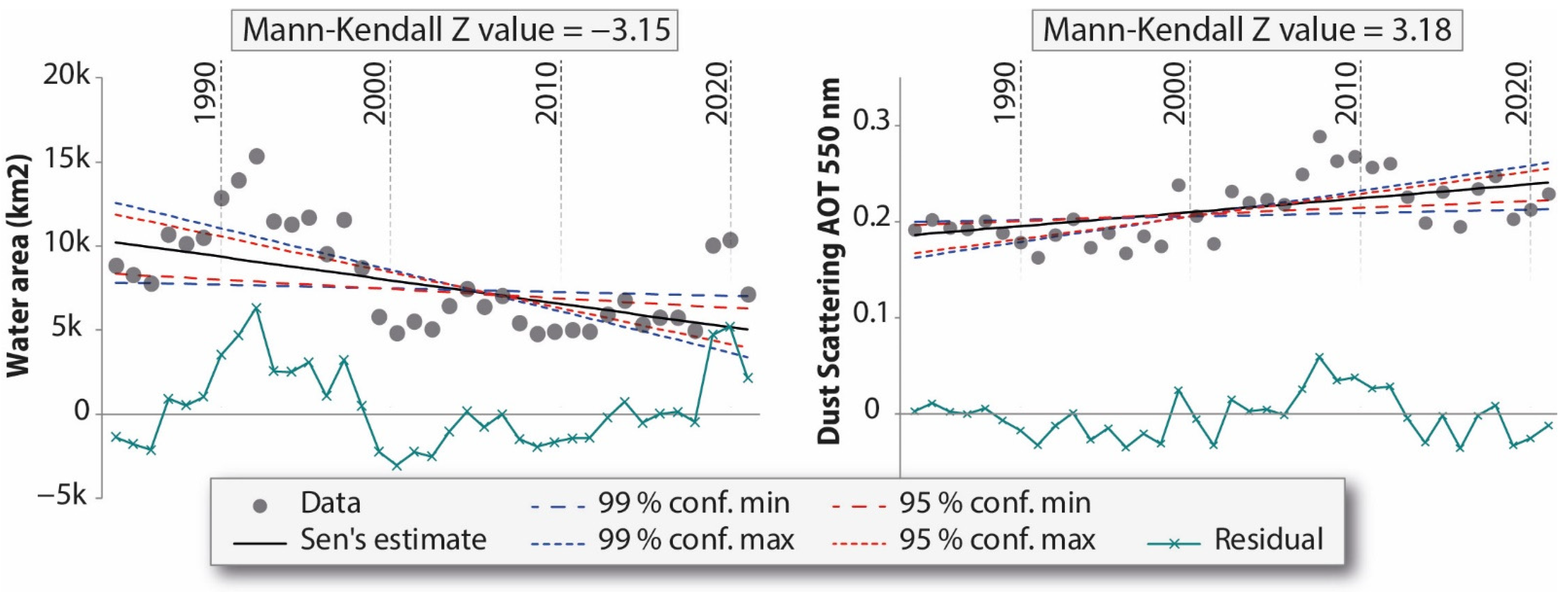
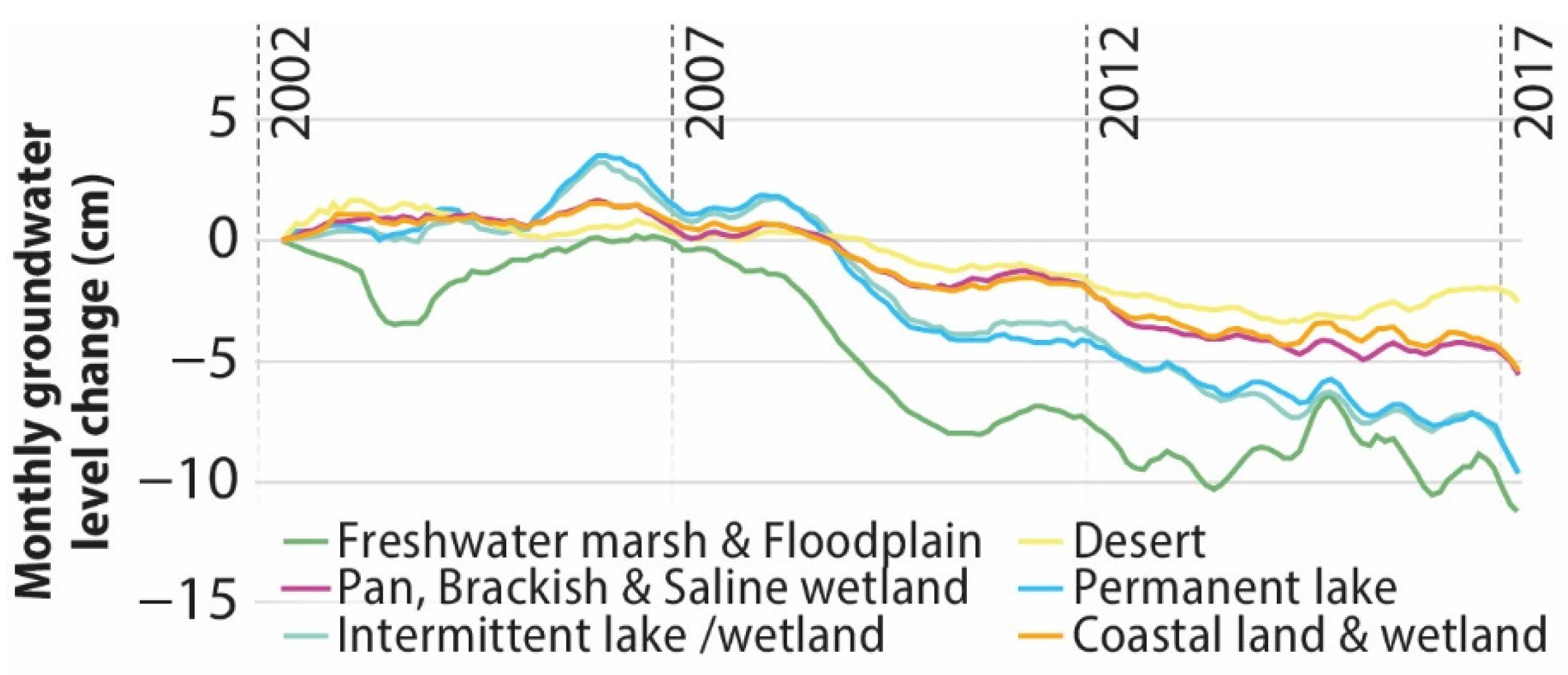

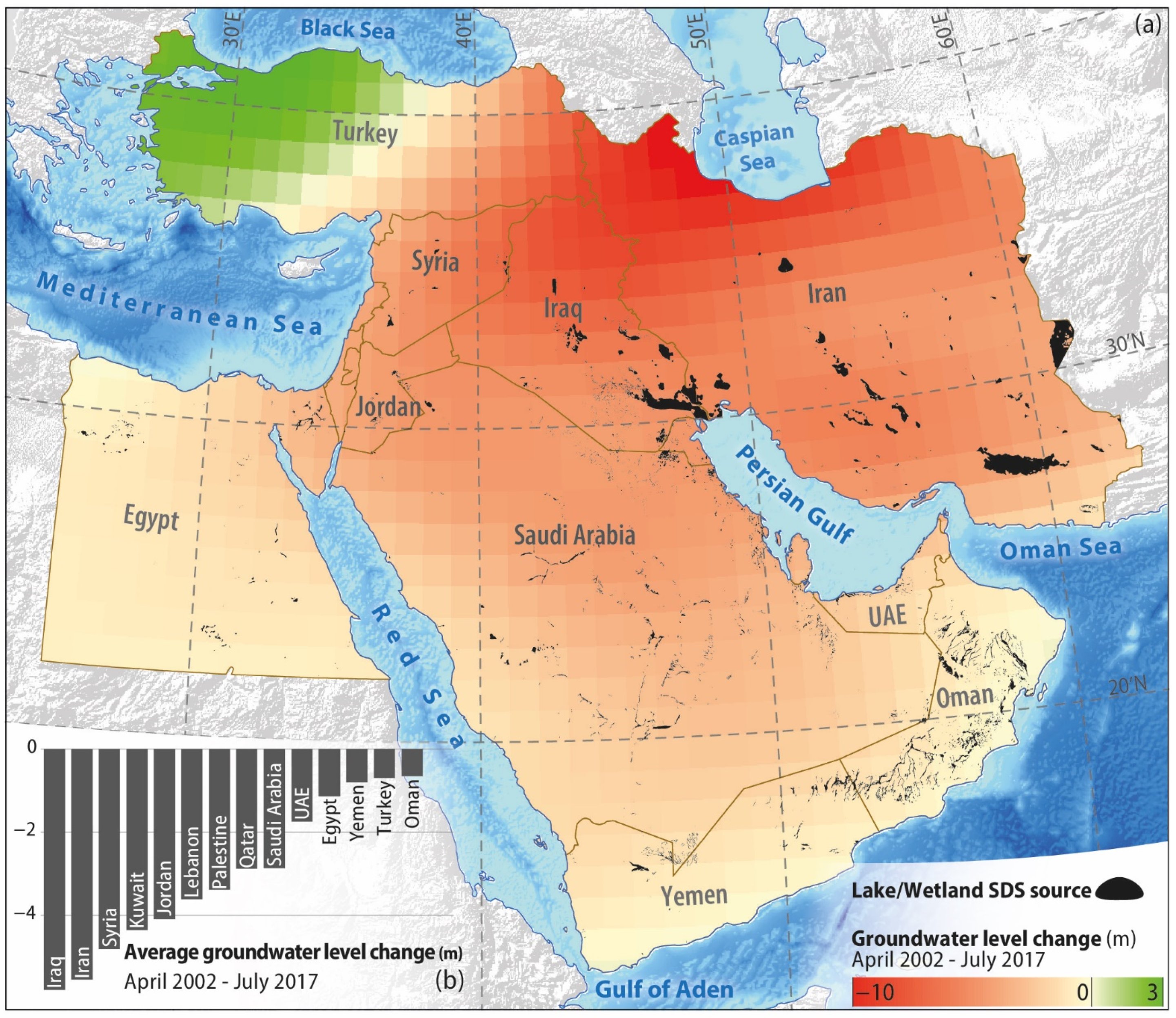
| Country | Desert | Permanent Lake | Freshwater Marsh & Floodplain | Coastal Wetland | Pan, Brackish & Saline Wetland | Intermittent Lake/Wetland | Coastal Land | Total | % |
|---|---|---|---|---|---|---|---|---|---|
| Bahrain | - | - | - | 12 | - | 31 | 43 | 86 | <0.1 |
| Egypt | 201,503 | - | - | 1938 | 3068 | 2755 | 6476 | 215,739 | 19.9 |
| Iran | 14,934 | 7362 | 3685 | 2972 | 9555 | 26,392 | 16,000 | 80,899 | 7.5 |
| Iraq | 74,858 | 2834 | 12,282 | - | - | 3974 | 695 | 94,643 | 8.8 |
| Jordan | 936 | - | - | - | 999 | 440 | 30 | 2406 | 0.2 |
| Kuwait | 5972 | - | - | 743 | - | 395 | 6042 | 13,152 | 1.2 |
| Oman | 108,898 | - | - | 415 | 10,977 | 13,192 | 12,572 | 146,053 | 13.5 |
| Qatar | - | - | - | 148 | 372 | 241 | 8417 | 9179 | 0.9 |
| Saudi Arabia | 396,711 | - | - | 2720 | 7528 | 12,117 | 24,562 | 443,639 | 41 |
| Syria | 3039 | 698 | - | - | 157 | 522 | - | 4416 | 0.4 |
| UAE | 10,980 | - | - | - | 7137 | 805 | 6843 | 25,765 | 2.4 |
| Yemen | 38,386 | - | - | 448 | - | 3531 | 3434 | 45,800 | 4.2 |
| Total | 856,215 | 10,894 | 15,966 | 9397 | 39,793 | 64,397 | 85,114 | 1,081,776 | 100 |
| % | 79.1 | 1.0 | 1.5 | 0.9 | 3.7 | 5.9 | 7.9 | 100 |
| Name | Pre-2000 | First Drought | Change in First Drought Compared to Post-2000 (%) | Second Drought | Change in Second Drought Compared to Pre-2000 (%) | |
|---|---|---|---|---|---|---|
| Water area (km2) | Iraq lake | 3942 | 3037 | −23.0 | 2496 | −36.7 |
| Marshes | 3343 | 1275 | −61.9 | 1699 | −49.2 | |
| Hamoun | 3535 | 990 | −72.0 | 899 | −74.6 | |
| Total | 10821 | 5301 | −51.0 | 5094 | −52.9 | |
| AOT | Iraq lake | 0.19 | 0.22 | 12.0 | 0.26 | 33.3 |
| Marshes | 0.13 | 0.15 | 18.1 | 0.18 | 40.6 | |
| Hamoun | 0.24 | 0.27 | 13.5 | 0.33 | 37.9 | |
| Mean | 0.19 | 0.21 | 14.5 | 0.26 | 37.3 |
Publisher’s Note: MDPI stays neutral with regard to jurisdictional claims in published maps and institutional affiliations. |
© 2022 by the authors. Licensee MDPI, Basel, Switzerland. This article is an open access article distributed under the terms and conditions of the Creative Commons Attribution (CC BY) license (https://creativecommons.org/licenses/by/4.0/).
Share and Cite
Papi, R.; Attarchi, S.; Darvishi Boloorani, A.; Neysani Samany, N. Characterization of Hydrologic Sand and Dust Storm Sources in the Middle East. Sustainability 2022, 14, 15352. https://doi.org/10.3390/su142215352
Papi R, Attarchi S, Darvishi Boloorani A, Neysani Samany N. Characterization of Hydrologic Sand and Dust Storm Sources in the Middle East. Sustainability. 2022; 14(22):15352. https://doi.org/10.3390/su142215352
Chicago/Turabian StylePapi, Ramin, Sara Attarchi, Ali Darvishi Boloorani, and Najmeh Neysani Samany. 2022. "Characterization of Hydrologic Sand and Dust Storm Sources in the Middle East" Sustainability 14, no. 22: 15352. https://doi.org/10.3390/su142215352






